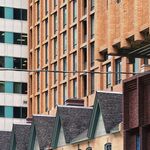Whoaccio
Senior Member
I dunno, I won't pass judgment on the plan (given the details in the article, it could have turned out crap or actually quite nice). The basic idea is right though. All other major cities (NYC, Chicago, Paris, London) had a guiding "grand plan" to ensure certain levels of architectural homogeneity and coherence, to say nothing of style. Toronto really has developed in a rather haphazard way. Sometimes I think it is a good thing, and it has left us with some very worthwhile neighborhoods, but other times you can't help but marvel at the dissonance in this city.
The one blank canvas we really have left are the Portlands, where our progress has left me rather unimpressed. Or take CityPlace. That has got to be the single largest development currently underway in Toronto with tens of thousands of planned residents. How do we serve them? A streetcar! Meanwhile we are extending the subway into government owned fields in an area which our own official plan doesn't target for significant growth. don't even get me started on Transit City, the triumph of the mediocre.
P.S. I like the idea of naming streets in Toronto after WW1 battles or otherwise significant Canadian moments. Why have King street instead of Paschendale?
The one blank canvas we really have left are the Portlands, where our progress has left me rather unimpressed. Or take CityPlace. That has got to be the single largest development currently underway in Toronto with tens of thousands of planned residents. How do we serve them? A streetcar! Meanwhile we are extending the subway into government owned fields in an area which our own official plan doesn't target for significant growth. don't even get me started on Transit City, the triumph of the mediocre.
P.S. I like the idea of naming streets in Toronto after WW1 battles or otherwise significant Canadian moments. Why have King street instead of Paschendale?




